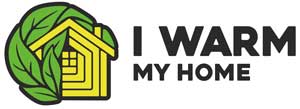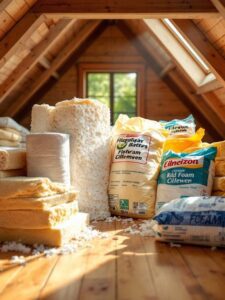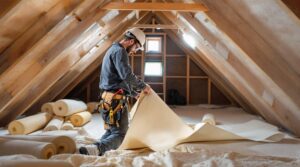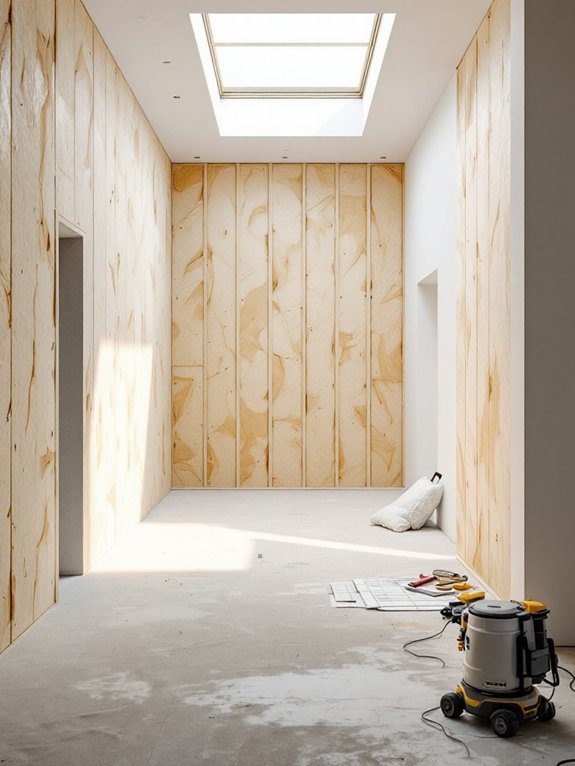You’ll see major changes in UK external wall insulation by 2025, driven by smart sensor integration and bio-based materials. These innovations can cut your energy costs by 15-30% while meeting stricter U-value requirements of 0.15 W/m²K under the Future Homes Standard. With installation costs ranging from £85-£175/m², you’ll typically recover your investment within 5-7 years through reduced bills. The combination of advanced technology and sustainability opens up compelling possibilities for property improvement.
Key Takeaways
- Smart sensor networks are being integrated into EWI systems, enabling real-time monitoring of insulation performance and potential energy savings of 15-30%.
- New regulatory standards require external walls to achieve a minimum U-value of 0.15 W/m²K under the Future Homes Standard 2025.
- Bio-based insulation materials like hemp and wool are gaining popularity as sustainable alternatives offering comparable performance to synthetic options.
- Installation techniques now emphasize precise mechanical fixing requirements and expansion joint placement every 12 meters for optimal performance.
- Return on investment periods are shortening to 5-7 years, with average homes saving £400-£600 annually on energy bills.
Smart Sensor Integration in Modern EWI Systems

While traditional external wall insulation (EWI) systems primarily focused on thermal performance, modern installations now incorporate smart sensor networks that monitor essential performance metrics in real-time.
You’ll find these integrated sensors measuring humidity levels, thermal bridging, and moisture content throughout your insulation system.
Smart technology enables you to track your home’s energy efficiency through a user-friendly dashboard, alerting you to potential issues before they become problematic.
You can monitor temperature differentials across wall sections and identify areas where your insulation might need attention.
The system’s predictive analytics help you optimize your heating and cooling patterns, potentially reducing your energy costs by 15-30%.
As a property owner, you’re now part of a growing community embracing data-driven solutions for better building performance.
Bio-Based and Sustainable Insulation Materials
As environmental concerns drive innovation in construction materials, bio-based insulation options have emerged as viable alternatives to traditional synthetic products in external wall installations. You’ll find these sustainable solutions deliver comparable thermal performance while reducing your carbon footprint.
| Material Type | R-Value | Cost/m² | Installation Complexity |
|---|---|---|---|
| Hemp Fiber | 3.5-3.8 | £45-55 | Medium |
| Wood Fiber | 3.7-4.0 | £50-60 | Low |
| Recycled Cotton | 3.3-3.6 | £40-50 | Low |
| Sheep’s Wool | 3.6-3.9 | £55-65 | Medium |
You’ll notice natural fibers like hemp and wool offer excellent moisture management properties, while recycled materials such as cotton provide cost-effective solutions. These materials aren’t just environmentally responsible – they’re creating healthier living spaces through their natural ability to regulate humidity and filter air pollutants.
Regulatory Changes and Compliance Standards

Recent updates to UK building regulations have markedly impacted external wall insulation requirements, with the Future Homes Standard 2025 introducing stricter U-value targets.
You’ll need to achieve a minimum U-value of 0.15 W/m²K for external walls, down from the previous 0.18 W/m²K standard.
The regulatory updates bring new compliance challenges you’ll have to navigate.
You’re now required to submit detailed thermal calculations, installation methodologies, and fire safety assessments before project approval. Additionally, you must guarantee your chosen insulation materials meet the updated sustainability criteria, including recycled content requirements and end-of-life considerations.
To stay compliant, you’ll want to partner with certified installers and maintain thorough documentation throughout your project.
These standards align with the UK’s commitment to achieving net-zero carbon emissions by 2050.
Cost Analysis and Return on Investment
Investment costs for external wall insulation typically range from £85 to £175 per square meter in the UK market, with variations based on system type, property size, and installation complexity.
While you’ll face substantial upfront expenses, the cost comparison against traditional heating solutions reveals significant long-term savings.
You can expect a return on investment within 5-7 years through reduced energy bills, with annual savings of £400-£600 for an average three-bedroom house.
Investment benefits extend beyond energy savings, including increased property value (typically 15-20%), reduced carbon footprint, and improved thermal comfort.
When you factor in current government incentives and rising energy costs, the financial case becomes even more compelling.
The payback period’s further shortened if you’re planning to stay in your property for an extended period.
Advanced Installation Techniques and Best Practices

Professional installation techniques make the difference between mediocre and outstanding external wall insulation performance.
You’ll need to guarantee proper surface preparation by thoroughly cleaning and repairing any damaged areas before applying advanced materials. Start with a base coat that’s perfectly level, as this creates the foundation for peak energy efficiency.
When you’re installing the insulation boards, maintain consistent pressure and use appropriate mechanical fixings – you’ll want at least five per square meter.
Don’t forget to incorporate expansion joints every 12 meters and pay special attention to window and door reveals.
You’re part of a community that values precision, so remember to use starter tracks at the base of walls and create effective weatherproof seals around all penetrations.
These techniques will maximize your installation’s durability and performance.
Performance Monitoring and Maintenance Strategies
Once you’ve installed external wall insulation, implementing a robust monitoring and maintenance program becomes critical for long-term performance.
You’ll need to conduct regular thermal imaging surveys to identify any potential cold spots or deterioration in the insulation system. As part of your performance optimization strategy, install smart sensors to track temperature variations and moisture levels in real-time.
Set up maintenance schedules that include quarterly visual inspections of the external render, checking for cracks, algae growth, or damage from impact.
You’ll want to address any issues promptly to prevent moisture ingress. Consider joining local building maintenance networks where you can share experiences and learn from other property owners.
Document all inspections and repairs in a digital log to track performance patterns and predict future maintenance needs.
Frequently Asked Questions
Can External Wall Insulation Be Installed During Winter Months?
You can install external wall insulation during winter, but you’ll face installation challenges with temperature and moisture. It’s best to choose days above 5°C and guarantee surfaces are completely dry for proper adhesion.
How Long Does External Wall Insulation Typically Last Before Needing Replacement?
Your external wall insulation can last 25-30 years when properly maintained. With good longevity factors like regular inspections and addressing maintenance requirements promptly, you’ll maximize its lifespan and protect your investment effectively.
Do I Need Planning Permission to Install External Wall Insulation?
You’ll typically need planning permission, though regulations vary by location. Check your local authority’s installation guidelines, as some areas offer permitted development rights for external wall insulation under specific conditions.
Will External Wall Insulation Affect the Appearance of Period Properties?
Your home’s timeless charm won’t vanish into thin air! While EWI can alter appearances, there are specialized heritage-friendly solutions that address aesthetic considerations. You’ll find options that respect your period property’s character.
Can External Wall Insulation Help Reduce Outdoor Noise Levels?
You’ll notice significant noise reduction benefits with external wall insulation. It acts as an effective soundproofing barrier, reducing outdoor noise levels by up to 50%. You’re likely to experience a much quieter indoor environment.
Conclusion
Just as a well-tailored suit adapts to your movements, you’ll find 2025’s EWI innovations flexing to meet your building’s needs. Smart sensors, bio-based materials, and stringent regulations are reshaping the industry’s landscape. By embracing these advancements, you’re not just insulating walls – you’re future-proofing your investment. With enhanced monitoring systems and installation techniques, you’ll maximize both energy efficiency and ROI in this evolving sector.









17 Responses
This actually answered my downside, thank you!
Great write-up, I¦m normal visitor of one¦s blog, maintain up the excellent operate, and It is going to be a regular visitor for a lengthy time.
Thanks , I have just been searching for information about this subject for ages and yours is the greatest I have discovered so far. But, what about the bottom line? Are you sure about the source?
You really make it appear so easy along with your presentation but I find this matter to be actually something which I believe I would never understand. It seems too complicated and extremely large for me. I’m looking forward in your subsequent submit, I¦ll try to get the hold of it!
Somebody essentially help to make seriously articles I would state. This is the very first time I frequented your web page and thus far? I amazed with the research you made to make this particular publish incredible. Magnificent job!
I don’t think the title of your article matches the content lol. Just kidding, mainly because I had some doubts after reading the article.
Your point of view caught my eye and was very interesting. Thanks. I have a question for you. https://www.binance.com/register?ref=IHJUI7TF
Your article helped me a lot, is there any more related content? Thanks! https://www.binance.info/register?ref=IHJUI7TF
Some really interesting info , well written and generally user genial.
I don’t think the title of your article matches the content lol. Just kidding, mainly because I had some doubts after reading the article. https://www.binance.info/ur/register?ref=SZSSS70P
Thank you for sharing superb informations. Your web site is very cool. I am impressed by the details that you¦ve on this website. It reveals how nicely you understand this subject. Bookmarked this website page, will come back for more articles. You, my friend, ROCK! I found just the information I already searched everywhere and simply couldn’t come across. What a perfect web-site.
I discovered your blog site on google and check a few of your early posts. Continue to keep up the very good operate. I just additional up your RSS feed to my MSN News Reader. Seeking forward to reading more from you later on!…
Your article helped me a lot, is there any more related content? Thanks! https://accounts.binance.info/de-CH/register-person?ref=W0BCQMF1
Thank you a lot for providing individuals with an extremely superb possiblity to check tips from here. It is usually very pleasing and stuffed with amusement for me and my office colleagues to search the blog a minimum of three times a week to read through the new guides you have got. And indeed, we are at all times contented concerning the spectacular pointers you serve. Selected 4 points on this page are in fact the most effective we have all ever had.
I don’t think the title of your article matches the content lol. Just kidding, mainly because I had some doubts after reading the article.
Thanks for sharing. I read many of your blog posts, cool, your blog is very good.
Your point of view caught my eye and was very interesting. Thanks. I have a question for you.